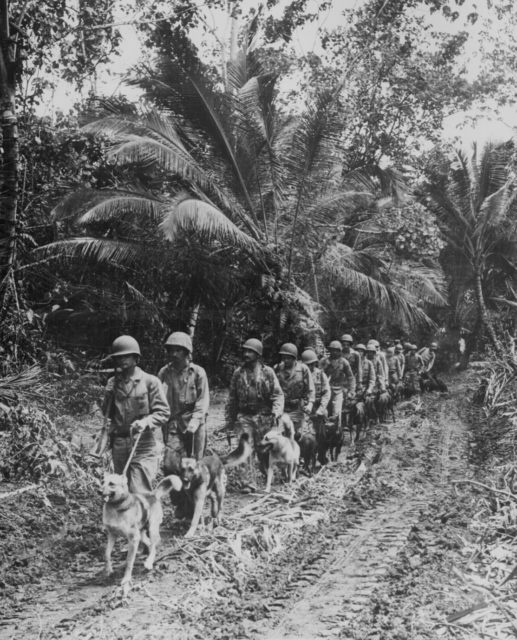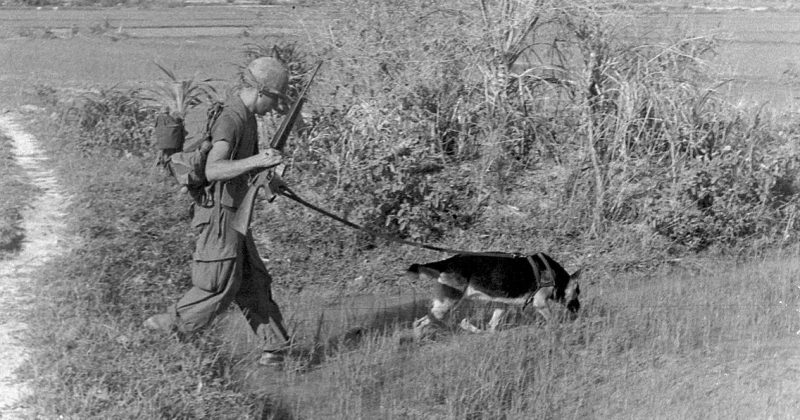We all know that “man’s best friend is his dog,” and many of us are fortunate enough to have experienced the unconditional love of a dog. We probably have never realized what we owe to these canine creatures for their brave loyalty – particularly with regard to military dogs, trained for work in war zones.
Dogs have always been known for their intelligence and their energy, but particularly for their remarkable ability to hear, see and smell which far exceeds those of humans. These attributes, recognized from earliest times, were used in wars by the ancient Egyptians, Persians, Greeks and Romans – amongst others – so the use of dogs in warfare today is not new.
During WWI, Airedales were used to successfully carry messages along the communication lines of the Western Front. Stubby, probably the most famous war dog of that time, was a Pit Bull who attained the rank of sergeant. He was excellent at using his senses, giving due warning of poison-gas attacks and enemy artillery fire. He was able to locate downed soldiers on the battlefield, and his very presence was a morale booster for the troops.
Serious training of war dogs was in its infancy in WWII, and many errors of training and questionable usage of dogs took place before settling down to that which best suited the dogs’ abilities.

As messengers on the war front, they were incomparable, for the dogs were quicker, smaller and more difficult to see, so were not as easily shot as were human messengers. Dogs trained for scouting and detection saved many a serviceman, by being able to detect and alert their handlers to the presence of the enemy from as far as 1000 yards away, thereby preventing ambushes. This was of particular value in rough terrain where visibility was limited. Some dogs were trained to attack on command, saving their handlers by timely assaults on the enemy.
Possibly the most useful work done by these military canines were those of sentry, guard and patrol duties. So many establishments were in danger of being sabotaged, thus requiring secure guarding. The dogs took the place of countless servicemen, thereby releasing them for active duty. The dogs would alert handlers to any intrusion by ‘strangers’ before the human eye or ear could see or hear them, allowing for the call-up of reinforcements.
Military ‘dogs of war’ trained for land-mine detection, initially were not entirely successful, becoming confused by the excessive movement and noise on the battlefront. Later, however, it was discovered that their smelling capabilities were such that they could distinguish the non-metal components of the newer landmines, which resulted in greatly increased detection.
Rex, a Labrador, in 1945 helped to sniff out so many mines in the Reichswald Forest that his platoon commander attributed the saving of many lives to his excellent work. Some dogs were trained for parachuting in behind enemy lines. Brian, a two-year-old Collie cross, became a “para-dog” and experienced heavy anti-aircraft fire when parachuted into France during the D-Day landings.
Chips, a crossbreed, helped in taking 10 Italian soldiers as prisoners, after having first attacked them in their machine-gun nest. Chips survived the war and returned home. A German Shepherd, Kaiser, was not so lucky, for after many missions, he and his handler were ambushed in Vietnam while on a search and destroy patrol in 1966, making him the first war dog to be killed in action during that war. Another German Shepherd, Nemo, also assigned to duty in Vietnam, was on patrol with his handler and came under attack where both were injured. In spite of an eye injury, Nemo attacked the enemy, giving the wounded handler the vital time needed to call for reinforcements before losing consciousness. Nemo then crawled on top of him to protect him from harm. Both dog and soldier recovered from their wounds.
Smoky, a feisty Yorkshire Terrier, was involved in dozens of combat missions in the Pacific arena surviving many air raids. She used her sharp sense of hearing to warn of incoming artillery shells, and in the Philippines, was once used to drag a vital telegraph wire through a narrow 70-foot pipe, which saved the workers and engineers from having to face the devastating enemy fire.
Dogs continue to be used in wars, even today. UK Special Forces in 2010 parachuted German Shepherd dogs with strapped-on video cameras, into Taliban strongholds where they were to search buildings.
Some ‘dogs-of-war’ served back home as coastal patrol dogs, (Coast Guard duty) and others did essential work of search and rescue, having been trained to find persons buried under the rubble after bombing raids.
Sadly, many war dogs never came home. Besides those killed in action, a large number were destroyed when their “military usefulness” was over, due in part, to fears of dangerous behavioral issues back in the real world. Procedures are now to be reviewed so that these military-trained war dogs are professionally checked and re-homed wherever possible, The Telegraph reported.
Many dogs carried out deeds of such bravery that a medal was instituted in 1943, to honor such brave animals. Known as the Dickin Medal, the words: ‘For Gallantry’ and ‘We also serve,’ are engraved upon it. We commemorate our soldiers who fought in wars, celebrating those who have survived and remembering those who died for us. It is fitting that we do the same for our ‘Dogs of War.’
